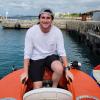Although they cover over 70% of our planet, only 0.6% of the world oceans are protected. It is estimated that we only know about 1 in 10 species in the ocean, which is unsurprising given that 90% of the ocean is more than half a mile deep and still remains largely unexplored. How might technology help us discover, understand and protect the vulnerable ecosystems below the waterline?
Marine Conservation is a fast-growing group in the WILDLABS community, capturing a wide variety of tech expertise within its member base, including those working with bioacoustic gear and hydrophones, AUVs and drones, sensors, machine learning, and more. By bringing together WILDLABS members from so many areas of conservation tech, the Marine Conservation group is the perfect place to collaborate on big, complex issues like marine biodiversity monitoring, coral reef health, plastic pollution, and sustainability.
The Marine Conservation group forum is also your place to chat about and solve the challenges unique to using conservation technology in marine environments. Whether you're struggling with deep-sea connectivity or salt water impacting gear longevity, or looking for remote solutions for long-term reef monitoring or biologging data collection, this group wants to help you explore the possibilities!
Check out some of the key marine conservation tech resources, conversations, and virtual events from across the WILDLABS platform:
Tutorials and Talks to Watch on Demand:
- Virtual Meetups: Developing cost-effective, open-source marine megafauna tracking, Jake Levenson
- Tech Tutors: How do I use open source remote sensing data to monitor fishing?, Max Schofield
- Virtual Meetups: eDNA for Aquatic Biodiversity, Alice Valentini
Case Studies, Tools, Research, and News:
- Southern Right Whales & Genome and Satellite Technology, Emma Carroll | eDNA & genomics, satellite data, biodiversity monitoring, climate change
- Building Experts Into AI, Whale Seeker | Machine learning, marine conservation, AI ethics
- Using AIS Data to Investigate the World’s Fishing Ports, Max Schofield | Remote sensing, data visualisation, fishing monitoring
- Small-scale fisheries and tech resources, Dan Steadman | Fishery monitoring, webinars, best practices
- Press Release: BAS Giant Iceberg Mission, British Antarctic Survey | Climate change, AUVs, remote sensing
- Case Study: Thermal imaging, drones, and loggerhead sea turtles, Megan Ossmann | FLIR, Duo Pro R camera, drones
- eDNA sampling to detect invasive snails in shipping ballast water, Gavin Shelton | Invasive species, eDNA, shipping
- Sustainable Fishing Challenges: Fish Catch Monitoring, Dan Steadman | Biologging, sensors, fishing monitoring
Conversations and Questions:
- Satellite tags for marine turtle recommendations | Alasdair Davies
- Calling all hydrophone users! | Team Open Acoustic Devices
- How difficult is it to build a buoy and constrain it in place? | Lindy Knowles
- Methods to detect Derelict Fishing Gear | Nandini Mehrotra
- Drone Mapping for Algal Blooms? | Harold Tay
- Minimising habitat impact of trawling gear | Dan Steadman
- Estimating carbon from 3d models of mangroves | Mark Brown
- Can we detect gillnets in turbid water? | Aurélie Shapiro
- New low cost DIY temperature loggers for reef monitoring | Harold Tay
- Machine learning to detect fish bomb blasts | Jamie Macaulay
Header Image: Emma Vogel
- @nicoboenisch
- | He / him / his
Co-Director FOS Europe, Conservation Strategist and Technical Advisor to the Miradi Software Team, Improving Conservation through Adaptive Management and Evidence-based Learning
- 0 Resources
- 0 Discussions
- 8 Groups
Swedish University of Agricultural Sciences
I study movement, behaviour and/or physiology using combine various sensors and tracking techniques. My focus is marine predators. However, my interest extends through the entire food web in all types of environment.
- 0 Resources
- 0 Discussions
- 7 Groups
Technology for Wildlife Foundation
- 0 Resources
- 3 Discussions
- 5 Groups
Siren Project Executive @ African Marine Mammal Conservation Organization (AMMCO). 20+ year in technology. Polyglot. Divemaster.
- 0 Resources
- 0 Discussions
- 3 Groups
Co-founder and CEO of Goldfish.io
- 0 Resources
- 1 Discussions
- 6 Groups
- @gob1thaasan
- | he/him
Gobithaasan started his career as a lecturer in 2009 and was promoted as an associate professor in 2015. His research current focus at Universiti Sains Malaysia is twofold; Topological Data Analysis and Machine Learning.
- 0 Resources
- 0 Discussions
- 4 Groups
Swedish University of Agricultural Sciences
I am a postdoctoral researcher using animal tracking technologies to investigate how chemical pollution influences fish movement and behaviour.
- 0 Resources
- 0 Discussions
- 7 Groups
- @Xavier_Mouy
- | he/him
I build software and hardware tools to help the analysis or the collection of passive acoustic data.
- 1 Resources
- 6 Discussions
- 6 Groups
A Marine Conservationist based in Malaysia
- 0 Resources
- 0 Discussions
- 5 Groups
Natural Solutions
Engineer, Ph.D in Computation Ecology. Interested in developing tools for the massive acquisition of high dimensional data from new technologies (e.g., imaging, omics), their analysis and visualization.
- 0 Resources
- 0 Discussions
- 13 Groups
- @SueWachia
- | she/her
A marine environmentalist with diverse experience in collaborating on multidisciplinary & community-centred marine research focused on: fisheries management, blue carbon strategies, seagrass ecosystems, & ocean literacy.


- 1 Resources
- 1 Discussions
- 7 Groups
- @CarlosAbrahams
- | He/him
Baker Consultants
Director of Bioacoustics and Senior Lecturer



- 2 Resources
- 24 Discussions
- 4 Groups
Article
Read in detail about how to use The Inventory, our new living directory of conservation technology tools, organisations, and R&D projects.
1 May 2024
Article
The Inventory is your one-stop shop for conservation technology tools, organisations, and R&D projects. Start contributing to it now!
1 May 2024
ZSL is looking for an enthusiastic research scientist to join the multidisciplinary team and help deliver a project in Wales to better understand the ecology of tope sharks (Galeus galeus) in North Cardigan Bay and the...
9 April 2024
WWF is looking for consultant(s) with expertise in spatial data mapping and analysis.
19 March 2024
Hussey Labs seeks a senior post-doctoral researcher/senior research associate for movement ecology of Greenland halibut in the context of fisheries management across Baffin Bay-Davis Strait, Eastern Canadian Arctic.
13 March 2024
Whether you’re an aspiring or established entrepreneur, an early-stage startup, or a researcher, apply to the Project 71 – A Venture Competition for Ocean Regeneration. This competition is for you if you have a bold...
4 March 2024
Join the mission to help tackle IUU fishing with cutting-edge tech! The Allan Institute for AI is seeking a Senior Software Engineer to accelerate efforts to make sure those working to restore our ocean have the tools...
21 February 2024
SEE Shell is an innovative phone app that uses machine learning to identify products made from the shell of the critically endangered hawksbill sea turtle.
14 December 2023
Using baited remote underwater videos (BRUVs) to survey seagrass habitats along Kenya’s North Coast
30 November 2023
The Department of Applied Ocean Physics and Engineering (AOPE) at the Woods Hole Oceanographic Institution (WHOI) seek to hire 1-2 scientists at any of the Assistant/Associate/Senior Scientist levels to develop research...
27 November 2023
TagRanger® is a state-of-the-art wildlife finding, monitoring and tracking solution for research, conservation and environmental professionals. With superior configurability for logging data, reporting location and...
23 November 2023
Prospective PhD students with a background in acoustics and an interest in Arctic ecology are encouraged to email Michelle EH Fournet
16 November 2023
May 2024
June 2024
October 2024
November 2023
event
| Description | Activity | Replies | Groups | Updated |
|---|---|---|---|---|
| Thanks, Thomas! I will definitely look into this more. I like the idea of finding ways to adjust the base plate/attachment point to something more biodegradable/sustainable, so... |
|
Biologging, Marine Conservation | 6 days 6 hours ago | |
| Congrats @MattyD797 and team!!! We do a lot of work in the underwater bioacoustic realm and your tool certainly seems like it would be a great instrumental addition to the... |
|
Acoustics, Build Your Own Data Logger Community, Marine Conservation, Protected Area Management Tools, Sustainable Fishing Challenges | 3 weeks 3 days ago | |
| We could always use more contributors in open source projects. In most open source companies Red Hat, Anaconda, Red Hat and Mozilla, people often ended up getting hired largely... |
|
Acoustics, AI for Conservation, Conservation Tech Training and Education, Early Career, Marine Conservation | 1 month 1 week ago | |
| Hello everyone, I'm interested in gathering insights on how the behavior of different species impacts the development and efficacy of... |
|
Biologging, Acoustics, Camera Traps, eDNA & Genomics, Emerging Tech, Marine Conservation | 1 month 1 week ago | |
| Hi all, I am searching for marine species projects that monitor orientation/IMU and/or acceleration data... |
|
Biologging, Marine Conservation | 1 month 2 weeks ago | |
| Hi Scott, thanks so much for sharing your thoughts here! It would be great to learn more about this, would you be interested in finding a time to chat? Thanks! |
|
Marine Conservation, Sustainable Fishing Challenges, Wildlife Crime | 2 months ago | |
| Ah yes. I didn’t notice that. Indeed it’s “near infrared”, 850nm lighting. |
|
Camera Traps, Marine Conservation | 2 months ago | |
| Am working on similar AI challenge at the moment. Hoping to translate my workflow to wolves in future if needed. We all are little overstretched but it there is no pressing... |
|
Camera Traps, AI for Conservation, Build Your Own Data Logger Community, Data management and processing tools, Marine Conservation, Protected Area Management Tools, Remote Sensing & GIS | 3 months ago | |
| I dont have anything written up but I can tell what parts we used and how we tested.Its pretty straightforward, we used this M10 Enclosure Vent from Blue Robotics: Along with... |
|
Build Your Own Data Logger Community, Acoustics, Camera Traps, Climate Change, East Africa Community, Marine Conservation, Open Source Solutions, Protected Area Management Tools | 3 months 2 weeks ago | |
| Thanks Aude, very useful. Will reach out to them! |
|
Early Career, Acoustics, eDNA & Genomics, Marine Conservation, Protected Area Management Tools | 3 months 3 weeks ago | |
| Thank you for sharing! Super interesting, as we don't see many underwater stereo cameras! We also use Blue Robotics components in our projects and have found them reliable and... |
|
Sensors, Camera Traps, Marine Conservation | 4 months ago | |
| If you are considering an external microphone and a towed system, then you would also be in a position to consider a raspberry pi with an external microphone with sbts-aru.... |
|
Acoustics, AI for Conservation, Marine Conservation, Sustainable Fishing Challenges | 4 months 1 week ago |
Sea turtle identification through pattern matching
2 July 2016 8:58am
18 July 2016 9:32am
Hi Jason,
I've had Ibeis and Wildbook on my radar for ages and have been meaning to ask you about the two projects, so this is a neat opportunity! Could you tell us a bit more about the two projects? I have been trying to figure out how they are integrated (and also seperate - it's a bit confusing from the outside!), so I'm interested to find out more about where you hoping to take the project(s).
Is the platform open to anyone interested in analysing images for patterns? How does it work?
Cheers,
Steph
28 September 2016 5:43am
Hi Steph,
Sorry for the late reply as I have other commitments currently.
In our case, we are using facial scales pattern because we found out that each individual have a distinctive scutes pattern (number, position & shape) on their face. Fins pattern are usable as well for identification but due to its complexity, the chances for errors (misidentification) are greater. This however can be solved when we have a more species specific pattern recognition software which can pin-point the exact distinctive features on the fins pattern.
Based on our findings in 2015, we found that facial and fins patterns are more reliable than the shell markings as it provided more details in identifying individuals. There are some individuals with very distinctive shell markings but unfortunetly, it does not apply to the whole population especially the juveniles. Most juveniles have almost similar shell markings.
In Perhentian Islands, observation of sea turtles while snorkeling or diving has become an opportunity for us to conduct the study. We have a team of trained research intern who went out for snorkel survey looking out for turtles every day throughout the season. Whenever a turtle is sighted, one of the research intern will skin-dive and photograph the top view of the turtle and both sides of the face. All the photos are then brought back to the research station and analyse using the pattern recognition software. The reason why we took the top view photo is because it is easier for us to know the sex of the individual when we analysed the photos.
Sorry to tell you that our website is currently not available. We have been trying to bring it back but there is a constant virus & spyware attack. We are now reachable only by Facebook page: https://www.facebook.com/perhentianturtleproject/?fref=ts
Regards,
Nazirul
Fish recorded singing dawn chorus on reefs just like birds
22 September 2016 5:02pm
A 3D printable, drone and ROV-mountable, water sampler
22 June 2016 4:28pm
The Coral Trait Database
5 May 2016 3:12pm
Blue Economy Challenge / Sustainable aquaculture for Indian Ocean developing countries
5 March 2016 2:14am
18 March 2016 12:46am
I'll be entering the Blue Economy Challege. Would be really cool to start a conversation and collaboration between community members here and others who join the challenge. What if entrants to the BEC got a link to WildLabs and invited to join this conversation after they submitted their application?
7 April 2016 2:35am
Jamieson, this is a great idea, and although my reply is rather delayed, it is not too late for me to update the message for Blue Economy Challenge applicants! I encourage applicants to the BEC to use this space to continue the conversation about technological innovations that will transform aquaculture.
2 May 2016 11:47am
Algae technology is central to innovation to conserve biodiversity against the threats of climate change. I am part of a global scientific group called Ocean Foresters. Our proposed Haven Atoll system aims to use algae to help save coral biodiversity and reduce ocean acidity. We are seeking partners for the Blue Economy Aquaculture Challenge.
In the northern section of Australia’s Great Barrier Reef, 95% of the coral is damaged or dead from excessive ocean heat. Coral bleaching is not limited to Australia, but is occurring in every ocean around the world. CO2 emissions are the cause of the crisis, but the real problem now is that emission reductions alone are just too slow to prevent catastrophic biodiversity loss. Immediate steps are needed to reduce the heat, acidity and nutrients that are killing our reefs. Algae is the key to save reefs by providing cooler and cleaner water in atolls. As Dr Tim Flannery argues in his 2015 book Atmosphere of Hope, the Ocean Foresters have presented compelling argument that large scale deployment of artificial forests of seaweeds, kelps and algae is the most promising response to fixing ocean health and removing CO2.
Ocean Foresters’ key proposal is called Haven Atolls, a system for protecting coral by growing large amounts of marine plants for fuel, food, fertilizer, fabric and fodder. Australia has the need, expertise, resources, locations and innovative culture to lead the world on Haven Atolls, targeted to the coral systems under most threat from global warming. Haven Atolls will produce fresh water, energy and algae products and protect local corals. Our key innovation is to bring cool nutrient-rich deep ocean water to the surface and feed it into coral atolls for sustainable aquaculture and to cool the coral during heat waves, protecting against global warming. The Haven Atoll will serve as a reservoir of biodiversity to seed reefs destroyed by bleaching. Haven Atolls will serve the global agendas of supporting food security and biodiversity, and will be critical to helping achieve negative carbon emissions, as identified by world governments in the Paris Climate Agreement as necessary to keep warming below two degrees.
Time is the enemy of coral. Our magnificent reefs are dying. Many have gone extinct or will soon. Algae systems can save the reefs while developing technology for sustainable energy and food supply and beginning to remove the dangerous extra carbon that fossil fuels have added to our air and sea. We urgently need partnerships for innovation, to implement rapid practical cost-effective methods to save our precious coral reefs from the looming extinction.
NOAA Webinar 14th April: Ocean Exploration and MPAs - Priorities, Technological Advances and Partnership
21 March 2016 2:28pm
How can technology help reduce manatee boat strikes?
9 February 2016 4:42pm
18 March 2016 5:23pm
Hi John,
Have you checked out Whale Alert? There may be some scope for applying/adapting the same technology for averting manatee strikes by applying it to the recreational boating sector.
Best regards,
Gavin

Beauty as a cheap monitoring tool for reefs?
26 November 2015 5:13pm



















































18 July 2016 9:19am
Hi Nazirul,
That is so interesting! My assumption was that you would be using the shell markings as the ID, I hadn't even considered that the facial and fin markings would be a more useful way to diferentiate individuals. I would have thought that getting a look at a turtle's shell would be easier than taking a photo that shows the fins or face in enough detail to analyse - is this not the case? Or do you use the facial scale patterns because the shells do not differ enough between individuals?
I'm also keen to hear more now about your methodology. How to you take your observations? If you're using pattern recognition software and Wildbook, you must be taking photos. Are these remotely triggered (i.e. underwater camera traps), or are they from photos taken by divers or people there monitoring in person?
Kate's link above doesn't seem to be working for me, is there a website we can visit to find out more?
Thanks in advance!
Cheers,
Steph